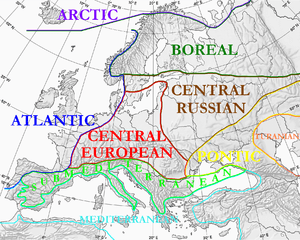Atlantic Europe facts for kids
Atlantic Europe is a special part of Europe. It's the western area that touches the Atlantic Ocean. People use this name to talk about it as a shared cultural area. They also use it to describe it as a natural region with similar plants and animals.
This region includes many places. It covers the British Isles (like Great Britain and Ireland). It also includes Iceland, Belgium, and the Netherlands. Parts of Portugal (central and northern) and northwestern Spain are in it too. This includes places like Galicia and Asturias. Western France and western Scandinavia are also part of Atlantic Europe. Even western and northern Germany fit into this area.
The weather and natural conditions are quite similar across this region. This creates similar landscapes. You can find many unique plants and animals that live only in this area. From a nature point of view, most of the Atlantic coastline is one big natural region. Scientists call this the European Atlantic Domain. It's part of a larger plant region called the Euro-Siberian botanic region.
Contents
Ancient Connections
Long ago, people in Atlantic Europe had strong connections. The Atlantic Bronze Age was a time from about 1300 to 700 BC. During this period, there was a lot of trade and cultural sharing. This happened between areas that are now Portugal, Spain, France, Great Britain, and Ireland. For example, tin from Atlantic Europe was traded all the way to the Mediterranean.
Archaeologists have found common things among ancient people here. They found similar tools, art, and buildings. This shows that people traded or shared ideas. Also, some studies suggest that certain groups of people in Atlantic Europe are genetically linked. This is different from people in Central or Mediterranean Europe.
One example of early connections is the European Megalithic Culture. This culture built huge stone structures like Stonehenge. Another example is the Atlantic Bronze Age. This time saw the making of special items like the "carp's tongue sword". These items were traded widely along the Atlantic coast.
The term Atlantic Europe is also used for areas where Celtic languages were spoken. It also refers to places influenced by Celtic culture.
Culture Today
Many experts believe that Atlantic Europe still shares a common culture. This culture started in ancient times. It continued to grow thanks to trade by sea. Geographers also note that the natural environment helped shape this shared culture. This created similar ways of life along the western European coasts.
Some of the first geographers to talk about this idea were Otero Pedrayo and Orlando Ribeiro. Pedrayo studied Galicia and said it had a strong "Atlantic character." Ribeiro explored his home country, Portugal. He linked northern Portugal to a wider Atlantic European culture.
Many other authors have developed this idea since the 1950s. These include P. Flatrès, Emyr Estyn Evans, and Richard Bradley. Patrick O'Flanagan said that Atlantic Europe is a cultural area. It stretches from Norway to central Portugal. It also includes Britain and Ireland.
Xoán Paredes agrees that there is a common cultural landscape in Atlantic Europe. This is especially true for Celtic areas. It's based on how people settled and used their space. This shows a strong cultural connection within the region.
Filmmaker Bob Quinn made a series called Atlantean. He suggests that western European Celtic culture is actually older. He thinks it's a pre-Celtic Atlantic culture. He believes it included people from the Maghreb (North Africa) like Berbers. He thinks this culture still exists today.
Atlantic Europe in Politics
There is a group of regions called the Atlantic Arc Commission. This group helps connect regions in Atlantic Europe. It works to represent their interests. It started in 1989. It includes 26 regions from Great Britain, France, Spain, and Portugal. The Atlantic Arc Commission is one of seven similar groups. These groups are part of the Conference of Peripheral Maritime Regions of Europe.
Genetic Connections
Scientists are still discussing the genetic links between people in Atlantic Europe. Some studies show that modern and Iron Age people from Britain and Ireland are genetically similar to other North Europeans. They are not as similar to southern Atlantic Europeans in Spain and France. However, these studies might not include smaller, isolated groups of people.
Other research suggests a shared ancestry across the Atlantic zone. This goes from northwest Iberia (Galicia) to western Scandinavia. This shared history might go back to the end of the last Ice Age.
See Also
- Atlantic Biogeographic Region
- Atlantic Modal Haplotype
- Celts and Norsemen
- Haplogroup R1b (Y-DNA)
- Oceanic climate
- Paleolithic continuity theory



